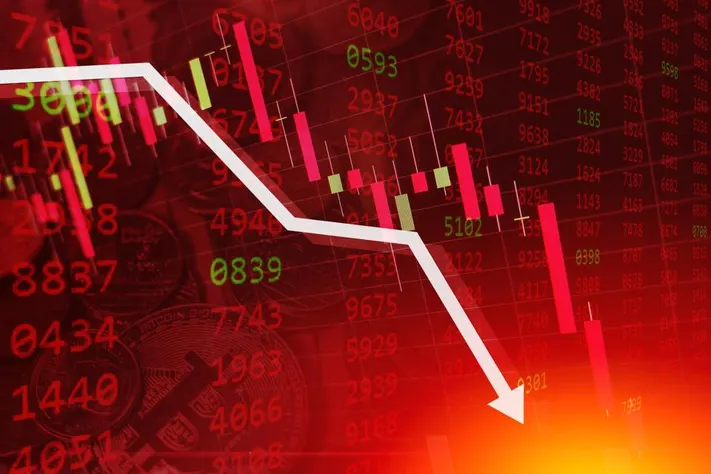What are the risks of investing in growth stocks? Many chase the thrill of high returns, but what lurks beneath the shine of potential? We’re diving headfirst into the unspoken pitfalls that could trip up any eager investor. I’ve seen fortunes rise and fall, and it’s time to share the truth behind these tantalizing tickers. From grappling with erratic swings to decoding the real worth of skyrocketing companies, I’ll break down how the dynamics of the market can play a cruel game with growth stocks. Stick around, and let’s get real about the hidden dangers that could put your hard-earned money on the line.
Understanding the Volatile Nature of Growth Stocks
The Challenges of Predicting Growth Stock Volatility
Growth stock volatility keeps many investors on their toes. Let me paint you a picture. Imagine hopping on a roller coaster; that’s what owning growth stocks can feel like. The highs are high, soaring as the company grows. But the lows? They can be scary.
These stocks swing in price more than others. Why? Because their future is a big question mark. People guess what they might earn. But guesses can be wrong. When they are, prices can drop fast. This is why predicting growth stock volatility is tough. It’s like guessing the weather weeks in advance.
To figure out when a stock might jump or dive, I look at something called high beta. High beta means a stock will likely move more than the market. If the market goes up a little, a high beta stock might go up a lot. But it works the other way too. When the market falls, these stocks can fall harder and faster.
High Beta Investments and Market Sensitivity
Let’s dig deeper into high beta investments. They’re like the market’s shadow. They follow the market’s moves but in a bigger way. Think of it like a dance. When the market takes a step, high beta stocks leap.
Investors like you and me must watch the market daily. A calm day might not stir high beta stocks much. But on wild days, hold onto your hat. Your high beta stocks might jump around like popcorn.
When the market’s shaky, these stocks feel it more. That’s market sensitivity. It’s why I always say, “Know your stock’s beta.” It helps understand this sensitivity.
In simple terms, growth stocks can be risky. They change price a lot and fast. High beta stocks do this even more. When the market moves, they really move. That’s why investors need to track the market. It helps them see where their high beta stocks might go. It’s not easy, but it’s key to smart investing in these wild rides.
Evaluating the True Value of High Growth Companies
The Role of Price-Earnings Ratios in Stock Valuation
Price-earnings ratios show how much you pay for stocks relative to earnings. They help decide if a stock is pricey or a deal. A high ratio might hint that a company’s stock costs more than what it earns, which can be risky.
Think of it like buying shoes. Would you spend a lot on shoes that wear out fast? Not likely. Just like with stocks, you want good value for money. If the price-earnings ratio is too high, the stock might be overvalued. This could mean trouble if the company’s earnings don’t grow as expected. When earnings fall short, stock prices can drop. This can happen to any company, but growth stocks feel it more.
A solid price-earnings ratio can change over time. What’s good today may not be tomorrow. It’s key to look at this number often and compare it to other companies. Some investors focus more on growth potential than current earnings. This can lead to ignoring high price-earnings ratios. If too many do this, stock prices can rise too fast. When reality sets in, those stocks might crash.
Pitfalls of Overoptimistic Growth Projections
Growth stocks often have high expectations. Everyone wants them to keep growing fast. But what if they don’t? If a company fails to meet growth hopes, its stock value can plunge. Consider tech firms that seem set for big things. They attract lots of excitement and cash.
Yet, they face huge risks. New competition can show up. Technologies can change. Rules can get tough. Any of these can hurt growth. Overconfidence in these stocks can lead to losses. Like when everyone at school thinks a certain toy will be cool forever, but then it’s not.
So, how do you spot overoptimism? Check past growth. Is it steady? Are there good reasons for it to continue? Compare it with peers. Are people paying much more for this stock than similar ones? If they are, caution is wise. You should also know how much risk you can take. Don’t put all your eggs in one basket. It’s smart to have different kinds of investments. This way, if one doesn’t do well, others might make up for it.
In the end, investing in growth stocks needs care. Watch the price-earnings ratio and stay real about future growth. Diversification is your friend. It can protect you when a company doesn’t turn out as everybody hoped. Remember: a balanced approach is usually safer in the long haul.
Financial Market Dynamics and Growth Stock Behavior
Impact of Interest Rate Hikes on Growth Securities
Interest rates impact growth stocks a lot. When rates go up, growth stocks often drop. Why does this happen? Well, growth companies need to borrow money to grow. When it costs more to borrow, their costs rise. This can lower their profits. Stocks also compete with bonds for investors. As bond yields rise, bonds can look more tempting.
Investors always seek profits. Higher interest rates can mean less profit for growth companies. That makes these growth stocks less attractive. So, stock prices may fall. Investors in growth companies should watch interest rates closely. Shifts can happen fast and unsettle the market. They may need to rethink their approach if rates climb.
Also, high beta investments can swing more than the market. A change in rates often hits them hardest. This means that during high interest times, high beta investments could see larger price drops. Good investors keep an eye on these patterns. Understanding interest rate trends can help them stay ahead.
Recognizing Signs of a Potential Bubble in the Tech Sector
Bubbles form when stock prices soar beyond real value. Often in tech, we see this happen. Why? Because tech grows fast and excites people. It’s easy to get swept up in the hype of overvalued tech stocks.
So, how do we spot a bubble? First, watch for overoptimistic growth projections. Are people saying a company will keep growing without end? Be cautious. No growth lasts forever. Next, check for high price-earnings ratios. A super high ratio can be a warning sign. Older, steady companies often have lower ratios than new tech ones. This difference could point to a bubble.
And don’t forget to think about market sentiment. If all you hear is positive talk about tech with no caution, beware. It’s good to get excited about new tech. But it’s smart to ask tough questions too.
If a bubble does burst, watch out. Prices can drop fast. You might see your stock value plummet. Think about having a mix of different stocks. Including both growth and value investing can offer protection. Also, keep tabs on things that could pop the bubble. Like bad earnings reports or shifts in Federal Reserve policy.
Investing right means dealing with risks. Growth stocks can tick upward fast, which is thrilling. But they can also fall just as suddenly, which can be rough. Being smart means watching the market, thinking long-term, and not going all in on one hot stock, even if it’s dazzling. Spread your risks and be ready to shift if signs start to look shaky. That’s how we can dodge the dangers that come with chasing the newest, brightest tech star.
Remember, the key to enduring success in growth stock investing lies in vigilance. Keep a sharp lookout for interest rate turns and signs of a bubble. These can greatly affect the profitability of growth companies. Stay aware, stay diverse in your approach, and keep learning. That’s how we navigate the tricky waves of the financial markets.
Adopting a Sustainable Long-Term Growth Investment Strategy
Diversification vs. Concentration in High-Growth Portfolios
Let’s talk shop. Some people bet big on just a few growth stocks. This move can spell trouble. Why? All of their cash eggs sit in one fragile basket. So if that basket drops, say goodbye to your eggs.
Diversification means spreading money across many stocks. It’s like planting many seeds. Some may not grow, but others will thrive. This strategy helps protect your investment garden.
Growth stocks can swing high and drop fast. That’s their nature. We call this “growth stock volatility”. By diversifying, you’re not at the mercy of just a few wild stocks.
High-growth areas, like tech, are a hot spot. People see these sectors boom and want in. This rush can inflate prices too much. We call these “overvalued tech stocks”. They’re like balloons waiting to pop.
Addressing the Risks of Aggressive Growth Strategies
Taking bold steps can lead to wins. But risks tag along too. Think of it as a high-stakes game. Aggressive growth strategies often mean putting money in high-beta investments. These stocks react wildly to market changes. So a bad day in the market? It’s a really bad day for these stocks.
Interest rate hikes are another problem. They can scare off investors from growth stocks. When rates go up, the cost of borrowing does too. Then, it’s tougher for growth companies to get cash. It can slow their roll and make stocks dip.
What about when everyone’s talking up a stock? This chatter can create a bubble. It’s when prices soar because of the talk, not true value. “Bubble in tech sector” is a term bankers use. It means a lot of tech stocks could have prices way above what they’re worth.
Long-term strategies think about droughts and storms. Will the growth sustain even if the market gets rough? “Sustainability of growth stocks” is a key thing to ponder. We aim for stocks that can ride out tough times.
Remember, risk can climb as fast as growth. Know your limit. Can you stick it out if things go south? This is where “investor risk tolerance” kicks in. It’s all about how much risk you can stomach.
Solid growth strategies need a clear road map. Diversify to protect your treasure. Watch out for overhyped stocks and swings in the market. Stay sharp on how higher costs of cash can hit growth stocks. And always match your moves to the risk you can handle. This way, your investment journey turns into a rewarding adventure, not a wild, unwelcome ride.
In this post, we dug into the ups and downs of growth stocks. We looked at why these stocks can bounce around and how their value links to market trends. We learned that growth stocks react strongly to market changes. We also saw that high-priced earnings ratios and too much hope can lead us astray.
We explored how interest rates and the fear of bubbles affect growth stocks. And lastly, we considered how to build a growth investment plan that lasts. Diversifying your investments and understanding the risks can help.
Remember, growth stocks can be a wild ride. Be smart, look hard at the numbers, and don’t chase dreams without doing your homework. Balancing risk and reward is key. I hope these insights help you make choices that bring growth to your portfolio in a steady way.
Q&A :
What are the potential drawbacks of investing in growth stocks?
Growth stocks are shares in companies that are anticipated to grow at an above-average rate compared to other firms in the market. However, the potential drawbacks of investing in these stocks include higher volatility, as growth stocks can swing widely in price due to speculative interest. Additionally, they often trade at higher price-to-earnings ratios, meaning there’s a risk of overpaying for growth that may not materialize. Overvaluation can lead to significant corrections if the company disappoints investors.
How does market volatility impact growth stock investments?
Market volatility can greatly impact growth stock investments, mainly because these stocks are often more sensitive to market changes and investor sentiment. During periods of high volatility, growth stocks may exhibit larger price swings, positively or negatively, compared to the broader market. This can lead to a higher risk of loss, especially for investors who do not have a long-term investment horizon and may need to sell during a downturn.
Are growth stocks a good investment during economic downturns?
Growth stocks may not always be the best investment during economic downturns, as these periods can be particularly challenging for companies focused on rapid expansion. During recessions or periods of slow economic growth, investors may gravitate towards more defensive stocks or value stocks, which are perceived as less risky. Growth stocks, on the other hand, might see decreased investor interest, leading to potential underperformance.
What is the risk-reward ratio typically like for growth stocks?
The risk-reward ratio for growth stocks is generally skewed towards higher risk and higher potential reward. Investors in growth stocks are betting on the companies’ potential to significantly increase earnings and, in turn, stock prices over time. Due to the speculative nature of their rapid growth prospects, there’s a heightened risk of volatility and loss. However, if the companies do achieve their growth targets, the rewards can be substantial.
Should diversification strategies include growth stocks?
Diversification strategies can include growth stocks as one component of a well-rounded portfolio. Including growth stocks can offer the potential for substantial capital appreciation. Nonetheless, it is important for investors to balance growth stock holdings with other types of investments to mitigate risk. A mix of growth stocks, value stocks, bonds, and other asset classes can help create a diversified portfolio capable of weathering various market conditions.



